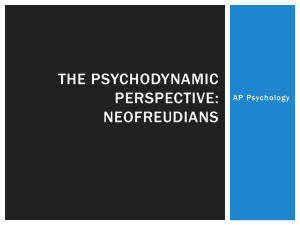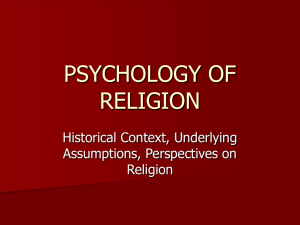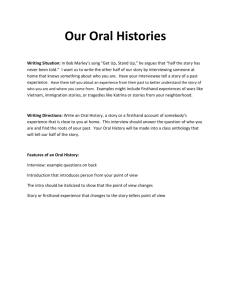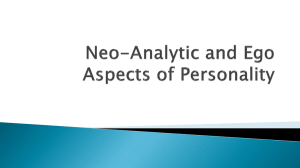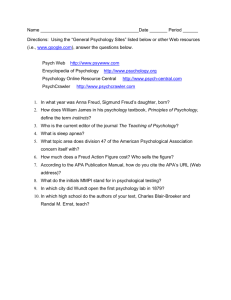PSYCHOLOGY 352
advertisement
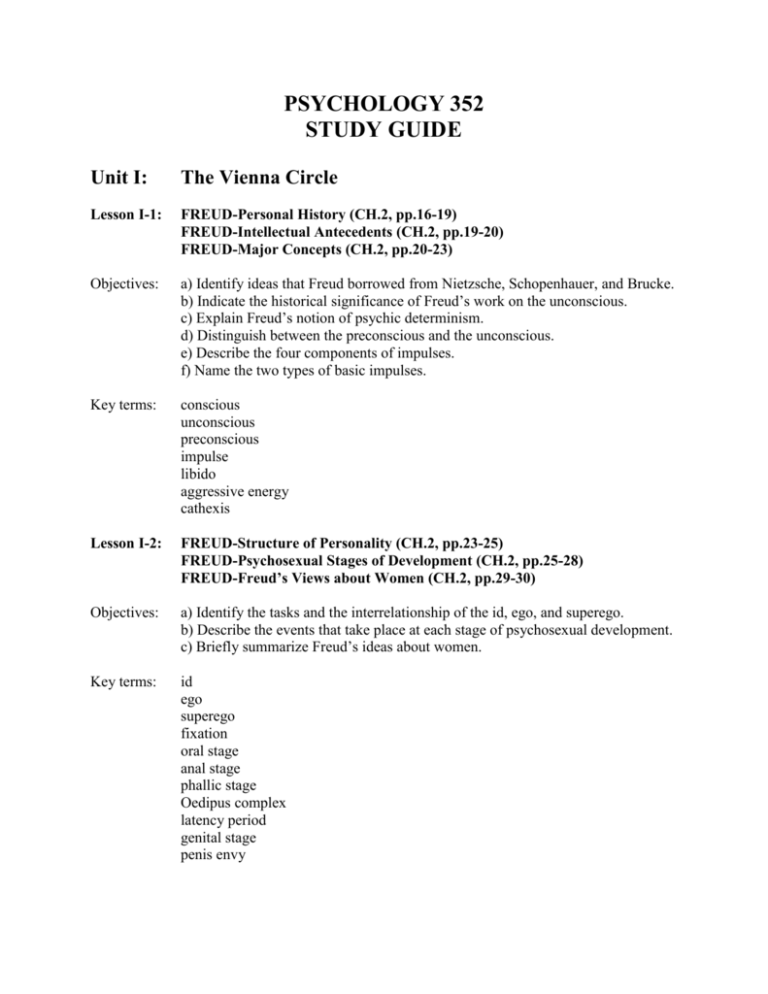
PSYCHOLOGY 352 STUDY GUIDE Unit I: The Vienna Circle Lesson I-1: FREUD-Personal History (CH.2, pp.16-19) FREUD-Intellectual Antecedents (CH.2, pp.19-20) FREUD-Major Concepts (CH.2, pp.20-23) Objectives: a) Identify ideas that Freud borrowed from Nietzsche, Schopenhauer, and Brucke. b) Indicate the historical significance of Freud’s work on the unconscious. c) Explain Freud’s notion of psychic determinism. d) Distinguish between the preconscious and the unconscious. e) Describe the four components of impulses. f) Name the two types of basic impulses. Key terms: conscious unconscious preconscious impulse libido aggressive energy cathexis Lesson I-2: FREUD-Structure of Personality (CH.2, pp.23-25) FREUD-Psychosexual Stages of Development (CH.2, pp.25-28) FREUD-Freud’s Views about Women (CH.2, pp.29-30) Objectives: a) Identify the tasks and the interrelationship of the id, ego, and superego. b) Describe the events that take place at each stage of psychosexual development. c) Briefly summarize Freud’s ideas about women. Key terms: id ego superego fixation oral stage anal stage phallic stage Oedipus complex latency period genital stage penis envy Lesson I-3: FREUD-Dynamics (CH.2, pp.30-33) FREUD-Structure (CH.2, pp.33-36) FREUD Therapy/Therapist (CH.2, pp.36-39) Objectives: a) List four events with a potential to cause anxiety. b) Name two ways to cope with anxiety. c) Describe the process of dreamwork. d) Discuss the aim of psychoanalysis and the role of the analyst. Key terms: anxiety psychoanalysis dreamwork wish fulfillment Lesson I-4: FREUD-Evaluation (CH.2, pp.39-40) FREUD-The Theory Firsthand (CH.2, pp.40-44) Objectives: a) Identify Freudian ideas that are currently: (i) accepted; (ii) debated; and (iii) criticized. Lesson I-5: JUNG-Personal History (CH.4, pp.84-87) JUNG-Intellectual Antecedents (CH.4, pp.87-89) JUNG-Major Concepts, part 1 (CH.4, pp.89-93) Objectives: a) Discuss Jung’s interpretation of his early images of God. b) Indicate two primary source of disagreement between Jung and Freud. c) Explain how the alchemical literature and Eastern thought influenced Jung. d) Describe Jung’s theory of type. e) Distinguish between the personal and the collective unconscious, according to Jung. Key terms: individuation introversion extraversion collective unconscious Lesson I-6: JUNG-Major Concepts, part 2 (CH.4, pp.93-104) Objectives: a) Describe six structures of personality and their function. b) List five basic assumptions of Jungian dream analysis. Key terms: archetype persona shadow active imagination PRACTICE TEST I-A Lesson I-7: JUNG-Dynamics (CH4, pp.104-108) JUNG-Structure (CH.4, pp.108-111) Objectives: a) Identify four steps that take place in the process of individuation. b) List at least three obstacles to individuation. c) Name two stages of the therapeutic process. Lesson I-8: JUNG-Evaluation (CH.4, pp.111-113) JUNG-Recent Developments (CH.4, pp.113) JUNG-The Theory Firsthand (CH.4, pp.114-115) Objectives: a) Describe the role of religion in Jung's ideas. b) Name three ways that Jung's ideas continue to be influential. Key terms: Myers-Briggs Type Indicator Lesson I-9: ADLER-Personal History (CH.5, pp.121-123) ADLER-Intellectual Antecedents (CH.5, pp.123-125) Objectives: a) Identify two ways in which Adler's ideas differed from Freud's. b) Explain how the ideas of Darwin, Freud, and Nietzsche influenced Adler. c) Briefly summarize the philosophy of holism shared by Adler and Smuts. Key terms: individual psychology Lesson I-10: ADLER-Major Concepts, part 1 (CH.5, pp.125-128) Objectives: a) Explain how Adler's own childhood experiences inspired his notion of the inferiority complex. b) Identify the primary concern for children, according to Adler. c) Describe Adler's notions of aggression and the striving for superiority. Key terms: organ inferiority inferiority complex compensation life goals Lesson I-11: ADLER-Major Concepts, part 2 (CH.5, pp.129-133) Objectives: a) List four dimensions of lifestyle. b) Name at least five basic principles of Adler's theory. Key terms: lifestyle schema of apperception social interest Lesson I-12: ADLER-Dynamics (CH.5, pp.133-136) ADLER-Structure (CH.5, pp.136-140) Objectives: a) Describe Adler's three obstacles to growth. b) Identify the primary cause of neurosis, according to Adler. c) Describe Adler's three goals of therapy. PRACTICE TEST I-B Lesson I-13: ADLER-Evaluation (CH.5, pp.140-141) ADLER-Recent Developments (CH.5, pp.141-142) ADLER-The Theory Firsthand (CH.5, pp.142-143) Objectives: a) Give three examples of Adler's influence on psychology. Lesson I-14: ANNA FREUD (CH.3, pp.52-59) Objectives: a) Identify Anna Freud's major contribution to psychoanalytic theory. b) Give an example of each of the seven defense mechanisms. Key terms: defense mechanisms repression denial rationalization reaction formation projection isolation regression sublimation Lesson I-15: KLEIN, WINNICOTT, KOHUT (CH.3, pp. 59-66) Objectives: a) Explain how love and hate are related, according to Klein. b) Identify the effects of aggression and love on the psyche. c) Summarize the basic premise of Klein’s object relation theory. d) Explain why it is better for a mother to be “good enough” than to be perfect, according to Winnicott. e) Describe the circumstances that give rise to a true self and a false self. f) Explain what Kohut meant by the term “self.” g) Distinguish between Freud’s and Kohut’s concept of narcissism. h) Explain how the processes of mirroring and idealizing change over time. i) Describe Kohut’s three transference situations. Key terms: good enough mother true self false self transitional objects mirroring idealizing selfobjects Lesson I-16: HORNEY-Personal History (CH.6, pp.148-151) HORNEY-Intellectual Antecedents (CH.6, pp.152-154) HORNEY-Major Concepts, part 1 (CH.6, pp.154-157) Objectives: a) Briefly summarize the three stages of Horney’s work. b) Identify the object of therapy according to Horney. c) Name the most important factor in Horney’s initial dissent with Freud. d) List the Freudian doctrines that Horney valued. e) Identify the factors that contribute to men’s view of women in Horney’s feminine psychology. f) Discuss the causes of the masculinity complex. Key terms: womb envy masculinity complex Lesson I-17: HORNEY-Major Concepts, part 2 (CH.6, pp.157-165) Objectives: a) Distinguish between the view of human beings supported by Horney and Freud. b) Describe Horney’s three interpersonal strategies of defense. c) Explain how self-idealization works as an intrapsychic defense strategy. d) Identify and describe four components of pride systems. Key terms: basic anxiety vicious circles real self compliant solution narcissistic solution perfectionistic solution arrogant-vindictive solution detachment idealized image search for glory pride system neurotic pride neurotic claims tyranny of the shoulds self-hate Lesson I-18: HORNEY-Dynamics (CH.6, pp.165-169) HORNEY-Nonclinical Applications (CH.6, pp.169-172) HORNEY-Evaluation (p.172) HORNEY-Conclusion (p.172-173) HORNEY-The Theory Firsthand (pp.173-174) Objectives: a) Identify the element of basic anxiety found in each interpersonal defense. b) List four nonclinical applications of Horney’s work. c) Name three defense strategies of animals that are related to Horney’s strategies. Key terms: basic conflict central inner conflict PRACTICE TEST I-C Unit II: Theories from Academic Psychology Lesson II-1: ERIKSON-Personal History (CH.8, pp.208-210) ERIKSON-Intellectual Antecedents (CH.8, pp.210-212) Objectives: a) Identify Erikson’s three major contributions to personality research. Lesson II-2: ERIKSON-Major Concepts, part 1 (CH.8, pp. 212-222) Objectives: a) List the basic assumptions of Erikson’s epigenetic model. b) Briefly describe the crises and strengths associated with Erikson’s eight stages. Key terms: crisis basic trust vs. basic mistrust autonomy vs. shame and doubt initiative vs. guilt industry vs. inferiority identity vs. identity confusion intimacy vs. isolation generativity vs. stagnation integrity vs. despair Lesson II-3: ERIKSON-Major Concepts, part 2 (CH.8, pp. 222-228) Objectives: a) List the main characteristics of identity. b) Distinguish between psychohistory and psychobiography. c) Describe the role of will in Erikson’s theory. Key terms: identity identity crisis case history psychobiography psychohistory Lesson II-4: ERIKSON-Structure (CH.8, pp.228-231) ERIKSON-Evaluation (CH.8, pp.231-232) ERIKSON-The Theory Firsthand (CH.8, pp.232-233) Objectives: a) Explain the statement, “Erikson was limited by psychoanalysis”. (p.231) Lesson II-5: JAMES-Personal History (CH.10, pp.268-271) JAMES-Intellectual Antecedents (CH.10, p.271-272) JAMES-Major Concepts, part 1 (CH.10, pp.272-275) Objectives: a) Describe the realization that helped James out of his depression. b) Compare James’ four layers of the self. Key terms: biological self material self social self spiritual self Lesson II-6: JAMES-Major Concepts, part 2 (CH.10, pp.275-283) Objectives: a) Identify four characteristics of consciousness. b) Explain how attention shapes personality. c) List the three stages of habit formation. d) Describe three ways to develop the will. Key terms: stream of consciousness fringe habit will PRACTICE TEST II-A Lesson II-7: JAMES-Dynamics (CH.10, pp.283-287) JAMES-Structure (CH.10, pp.287-289) JAMES-Evaluation(CH.10, pp. 289-290) Objectives: a) Describe the basic premise of the James-Lange theory. b) Explain James’ theory of pragmatism. c) Identify three obstacles to growth, according to James d) Identify James’ link to humanistic psychology, behaviorism and transpersonal psychology. Key terms: pragmatism personal blindness Lesson II-8: JAMES-Psychology of Consciousness (CH.10, pp.290-301) JAMES-Evaluation (CH.10, p.301-302) JAMES-The Theory Firsthand (CH.10, pp.302-304) Objectives: a) Discuss the implications of research findings related to psychedelics, biofeedback, meditation, hypnosis, and multiple personality. Lesson II-9: SKINNER-Personal History (CH.11, pp.314-316) SKINNER-Intellectual Antecedents (CH.11, pp.316-318) SKINNER-Major Concepts, part 1 (CH.11, pp.319-322) Objectives: a) Explain the significance of Walden Two. b) Summarize the impact that the work of Watson and Pavlov had on Skinner. c) State the goal of Skinner’s behavioral research. d) Describe Skinner’s view of personality. e) List six psychological constructs that Skinner classified as “explanatory fictions”. Key terms: canon of parsimony contingencies explanatory fiction Lesson II-10: SKINNER-Major Concepts, part 2 (CH.11, pp.323-329) Objectives: a) Describe the process of operant conditioning. b) Identify the core of Skinner’s position about behavior. c) Explain why punishment is an inadequate means of controlling behavior. Key terms: respondent behavior operant behavior operant conditioning reinforcer functional analysis Lesson II-11: SKINNER-Structure (CH.11, pp.329-333) SKINNER-Therapy (CH.11, pp.333-335) Objectives: a) Identify the main source of gender differences, according to Skinner. b) Explain Skinner’s view of emotions, thinking, and knowing. c) Describe the primary function of therapy, according to Skinner. Lesson II-12: SKINNER-Beyond Behaviorism (CH.11, pp.335-338) SKINNER-Evaluation (CH.11, pp.338-340) SKINNER-The Theory Firsthand (CH.11, pp.340-341) Objectives: a) Explain Skinner’s view of cognitive psychology. b) Describe the function of applied behavioral analysis. Key terms: programmed learning PRACTICE TEST II-B Lesson II-13: COGNITIVE-Researching Human Cognition (CH.12, pp.347-348) COGNITIVE-Computer Models and Human Information Processing (CH.12, pp.348-351) Objectives: a) Identify specific similarities between human cognition and the processing of information by computers. b) Identify two aspects of human cognition that are difficult for computers to replicate. c) Explain Varela, Thompson, & Rosch’s notion of enactment. Key terms: human cognition information processing Lesson II-14: COGNITIVE-Aaron Beck and Cognitive Therapy (CH.12, pp.351-355) COGNITIVE-Evaluation (CH.12, p.355) COGNITIVE-The Theory Firsthand (CH.12, pp.355-356) Objectives: a) Identify a similarity in the philosophies of Beck and Kelly. b) List four logical principles of the cognitive approach to psychotherapy. c) Name 10 types of distortions that occur in the thinking of depressed people. Key terms: automatic thoughts Lesson II-15: KELLY-Personal History (CH.13, pp.361-363) KELLY-Intellectual Antecedents (CH.13, pp.363-365) Objectives: a) Explain Kelly’s metaphor of “man-the-scientist.” b) Describe the influence of Dewey, Sartre, Korzybski and Moreno on Kelly’s personal construct theory. Key terms: personal construct man-the-scientist Lesson II-16: KELLY-Major Concepts (CH.12, pp.363-371) Objectives: a) Describe eight basic assumptions (i.e., postulates and corollaries) of personal construct theory in your own words. Key terms: constructive alternativism Lesson II-17: KELLY-Transitional Constructions (CH.13, pp.373-377) KELLY-Dynamics (CH.13, pp.377-381) Objectives: a) Explain how personal construct theory accounts for anxiety, threat, fear, guilt, aggressiveness and hostility. b) Name and describe the three phases of the C-P-C cycle.. c) Summarize Kelly’s view of the creativity cycle. d) Explain how the rep grid is used in therapy. e) Give an example of a systemic bow tie. f) Try the repertory test on p. 380. Key terms: self-characterization sketch Lesson II-18: KELLY-Diagnosis (CH.13, pp.381-383) KELLY-Therapy (CH.13, pp.383-385) KELLY-Evaluation (CH.13, pp.385-386) KELLY-Theory Firsthand (CH.13, pp.386-387) Objectives: a) Explain how the credulous approach works in the context of therapy. b) Describe the process of fixed role therapy. Key terms: transitive diagnosis constructivism PRACTICE TEST II-C Unit III: East Meets West Lesson III-1: ROGERS-Personal History (CH.14, pp.394-398) ROGERS-Intellectual Antecedents (CH.14, pp.398-399) Objectives: a) Name four contributions that Rogers made to the field of psychology. b) Describe the key difference between client-centered therapy and other forms of psychotherapy. c) Identify two Eastern schools of thought that have ideas similar to those of Rogers. Lesson III-2: ROGERS-Major Concepts (CH.14, pp.399-404) Objectives: a) State the fundamental assumption of Rogers’ work. b) Identify the primary source of motivation in Rogers’ theory of personality. c) Give examples of two kinds of incongruence. d) Try the congruence exercise on pp.403-404. Key terms: field of experience ideal self self-actualizing tendency personal power congruence incongruence Lesson III-3: ROGERS-Dynamics (CH.14, pp.405-407) ROGERS-Structure (CH.14, pp.407-411) ROGERS-The Fully Functioning Person (CH.14, pp.411-412) Objectives: a) Explain how a child’s need for positive regard can produce conditions of worth. b) Describe the effects that conditions of worth can have on personality. c) List four elements of a successful marriage, according to Rogers. d) Distinguish among Rogers’ three ways of knowing. e) Describe three characteristics of a fully-functioning person. Key terms: conditions of worth subjective knowing objective knowing interpersonal knowing fully-functioning person Lesson III-4: ROGERS-Person-Centered Therapy (CH.14, pp.412-416) ROGERS-Encounter Groups (CH.14, pp.416-418) Objectives: a) Identify the key characteristics of a client-centered therapist. b) List Rogers’ necessary and sufficient conditions for successful therapy. Key terms: unconditional positive regard Lesson III-5: ROGERS-Evaluation (CH.14, pp.418-420) ROGERS-The Theory Firsthand (CH.14, pp.420-422) Objectives: a) Discuss the criticisms that have been raised concerning Rogers’ work. b) Discuss Rogers’ response to his critics. Lesson III-6: MASLOW-Personal History (CH.15, pp.429-430) MASLOW-Intellectual Antecedents (CH.15, pp.431-432) Objectives: a) Describe the major difference between Maslow’s philosophy and that of Freud. b) Identify the ideas of Kurt Goldstein that influenced Maslow’s work. PRACTICE TEST III-A Lesson III-7: MASLOW-Major Concepts, part 1 (CH.15, pp.432-440) Objectives: a) Describe the five levels of Maslow’s hierarchy of needs. b) List 15 characteristics of self-actualizing people. c) Identify eight ways in which people self-actualize. Key terms: hierarchy of needs physiological needs psychological needs self-actualization metamotivation metagrumbles Lesson III-8: MASLOW-Major Concepts, part 2 (CH.15, pp.440-445) Objectives: a) Distinguish between healthy and transcending self-actualizers. b) Distinguish between deficiency motivation and being motivation. Key terms: peak experiences plateau experiences deficiency motivation being motivation deficiency cognition being cognition being values deficiency love being love eupsychia synergy Lesson III-9: MASLOW-Dynamics (CH.15, pp.445-446) MASLOW-Structure (CH.15, pp.446-450) MASLOW-Recent Developments (CH.15 p.450) MASLOW-Evaluation (CH.15, pp.450-451) Objectives: a) Explain the relation between the lower needs and the need for selfactualization. b) List three factors that can limit self-actualization. c) Distinguish between problem-centered and means-centered work styles. d) Describe the role of the therapist, according to Maslow. e) List three of Maslow’s central contributions to psychology. Key terms: desacralization Jonah complex problem-centered means-centered Lesson III-10:MASLOW-Transpersonal Psychology (CH.15, pp.451-458) MASLOW-The Theory Firsthand (CH.15, pp.459-460) Objectives: a) Identify the basic tenet of transpersonal psychology. b) List the four basic premises of the perennial model. c) Distinguish between the paradigms of transpersonal and traditional psychology. d) Distinguish between Wilber’s outward arc and inward arc. e) List Grof’s four categories of psychedelic experiences. Key terms: paradigm outward arc inward arc Lesson III-11:HINDUISM-History (CH.16, pp.466-468) Objectives: a) Identify the two aspects of yoga. b) Explain the significance of the Bhagavad-Gita. c) Describe the three most influential schools of Hindu thought. Key terms: Yoga Vedas Vedanta Bhagavad-Gita Mahabharata samadhi Lesson III-12:HINDUISM-Major Concepts, part 1 (CH.16, pp.468-472) Objectives: a) Explain the dualism between Spirit and Nature. b) Give an example of the interplay of the three gunas. c) Identify foods that are tamasic, rajasic, and sattvic. d) Describe the sequence of effects associated with karma (Figure 16.1). Key terms: Self gunas tamas rajas sattva chitta karma samskaras guru PRACTICE TEST III-B Lesson III-13:HINDUISM-Major Concepts, part 2 (CH.16, pp.472-485) Objectives: a) Describe each of the major schools of Yoga. b) Explain the concept of Prana, or vital energy. c) Distinguish among the seven chakras. Key terms: Karma-yoga Jnana-yoga Bhakti-yoga Hatha-yoga nadi prana mantra Mantra-yoga Laya-yoga kundalini Kundalini-yoga chakras abstentions observances posture pranayama interiorization Lesson III-14:HINDUISM-Dynamics (CH.16, pp.486-488) HINDUISM-Structure (CH.16, pp.488-492) HINDUISM-The Theory Firsthand (CH.16, pp.492-493) Objectives: a) Describe the four stages of the Indian life cycle. b) Identify the five obstacles to growth in Hinduism. c) Distinguish between Yoga and psychotherapy. Key terms: ignorance egoism desire aversion attachment nonattachment fear tapas Lesson III-15:BUDDHISM-History (CH.17, pp.499-501) BUDDHISM-Major Concepts, part 1 (CH.17, pp.502-505) Objectives: a) Distinguish between the two major schools of Buddhism. b) Describe the three characteristics of existence. c) Identify the Four Noble Truths and the Eightfold Path. Key terms: Buddha Theravada Mahayana impermanence interdependence selflessness dissatisfaction Lesson III-16: BUDDHISM-Major Concepts, part 2 (CH.17, pp.505-511) Objectives: a) Compare the two major styles of Zen meditation. b) Distinguish between an Arhat and a Bodisattva. Key terms: Zen zazen koan Soto mindfulness enlightenment nirvana satori kensho Lesson III-17:BUDDHISM-Dynamics (CH.17, pp.511-517) Objectives: a) Describe the primary obstacles to growth in Buddhism. b) Explain the symbolism of the ox-herding pictures (pp.512-521). Lesson III-18:BUDDHISM-Structure (CH.17, pp.517-525) BUDDHISM-Evaluation (CH.17, pp.525-527) BUDDHISM-Recent Developments (CH.17, pp.527-528) BUDDHISM-The Theory Firsthand (CH.17, pp.529-530) Objectives: a) Describe the correct way to look on other human beings, according to Buddhism. b) Discuss the role of will, emotions, and the intellect in Buddhism. c) Identify the principles that Zen shares with psychoanalysis and Gestalt therapy. Key terms: vipassana PRACTICE TEST III-C




